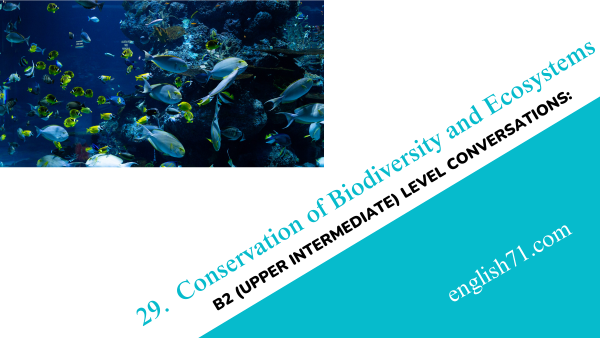B2 (Upper Intermediate) level Conversations: (29) Conservation of Biodiversity and Ecosystems

Monica: Hey Mike! Have you been following the news on biodiversity conservation lately?
Mike: Hi Monica! Yeah, I’ve been keeping an eye on it. There’s a lot of concern about the state of our ecosystems. What caught your attention?
Monica: I was reading about the decline in bee populations and its impact on pollination. It’s quite alarming considering their crucial role in maintaining biodiversity.
Mike: Absolutely! Bees are essential for pollinating many crops and wild plants. Have you come across any initiatives aimed at protecting them?
Monica: Yes, there are efforts to create more bee-friendly habitats by planting native flowers and reducing pesticide use. It’s inspiring to see communities and organizations taking action.
Mike: Definitely! It’s crucial to address the underlying factors contributing to their decline. I’ve also been reading about threats to marine biodiversity, especially coral reefs.
Monica: Yes, coral reefs are incredibly diverse ecosystems, but they’re facing pressures from climate change and human activities like overfishing and pollution. Have you seen any strategies for reef conservation?
Mike: I’ve seen projects focused on coral reef restoration, where scientists are growing coral fragments in nurseries and transplanting them onto damaged reefs. It’s a promising approach but requires long-term commitment.
Monica: That’s fascinating! It shows how human intervention can help restore ecosystems. I’ve also been learning about the importance of protecting biodiversity hotspots.
Mike: Biodiversity hotspots are areas with high species diversity and endemism, but they’re also under threat from habitat loss and fragmentation. It’s crucial to prioritize their conservation.
Monica: Absolutely! Preserving these areas not only protects unique species but also ensures ecosystem services like clean water and air. Have you encountered any innovative conservation methods?
Mike: Yes, there are technologies like satellite monitoring and drones that help track changes in ecosystems and identify areas in need of protection. It’s exciting to see how technology is being used for conservation efforts.
Monica: Technology indeed plays a significant role in conservation. However, community involvement and policy support are equally important. Have you seen any successful examples of community-led conservation projects?
Mike: Definitely! Community-based conservation initiatives empower local communities to take ownership of their natural resources, leading to more sustainable outcomes. It’s a holistic approach that considers social, economic, and environmental factors.
Monica: I couldn’t agree more. Inclusive and participatory approaches are essential for effective conservation. It’s encouraging to see diverse stakeholders coming together for a common cause.
Mike: Absolutely, Monica. By working together and combining our efforts, we can make a real difference in preserving biodiversity and protecting our planet’s ecosystems.
Monica: Well said, Mike! Let’s continue to stay informed and advocate for biodiversity conservation in our communities.
Mike: Definitely, Monica! Together, we can create a healthier and more sustainable environment for future generations.



Summary:
Monica and Mike engage in a thoughtful discussion about biodiversity conservation. They discuss various threats to ecosystems, including declining bee populations and coral reef degradation, highlighting the importance of community involvement and innovative conservation methods. They emphasize the need for collaboration and holistic approaches to address these challenges effectively. Their conversation underscores the significance of protecting biodiversity for the well-being of both ecosystems and human communities.

